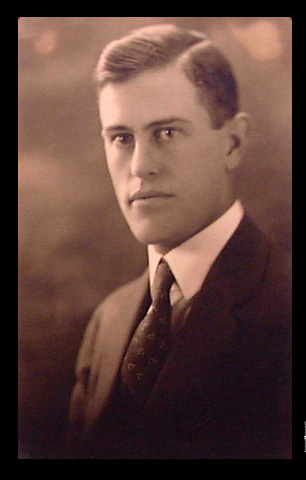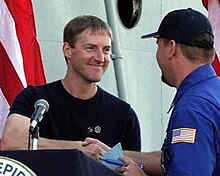A vertical take-off and landing (VTOL) aircraft is one that can take off and land vertically without relying on a runway. This classification can include a variety of types of aircraft including helicopters as well as thrust-vectoring fixed-wing aircraft and other hybrid aircraft with powered rotors such as cyclogyros/cyclocopters and gyrodynes.

Charles Augustus Lindbergh was an American aviator and military officer. On May 20–21, 1927, he made the first nonstop flight from New York City to Paris, a distance of 3,600 miles (5,800 km), flying alone for 33.5 hours. His aircraft, the Spirit of St. Louis, was designed and built by the Ryan Airline Company specifically to compete for the Orteig Prize for the first flight between the two cities. Although not the first transatlantic flight, it was the first solo transatlantic flight and the longest at the time by nearly 2,000 miles (3,200 km). It became known as one of the most consequential flights in history and ushered in a new era of air transportation between parts of the globe.

The Orteig Prize was a reward of $25,000 offered in 1919 by New York City hotel owner Raymond Orteig to the first Allied aviator, or aviators, to fly non-stop from New York City to Paris or vice versa. Several famous aviators made unsuccessful attempts at the New York–Paris flight before the relatively unknown American Charles Lindbergh won the prize in 1927 in his aircraft Spirit of St. Louis.

The Ansari X Prize was a space competition in which the X Prize Foundation offered a US$10,000,000 prize for the first non-government organization to launch a reusable crewed spacecraft into space twice within two weeks. It was modeled after early 20th-century aviation prizes, and aimed to spur development of low-cost spaceflight.

The Spirit of St. Louis is the custom-built, single-engine, single-seat, high-wing monoplane that was flown by Charles Lindbergh on May 20–21, 1927, on the first solo nonstop transatlantic flight from Long Island, New York, to Paris, France, for which Lindbergh won the $25,000 Orteig Prize.
This is a list of aviation-related events from 1927:
This is a list of aviation-related events from 1928:
A transatlantic flight is the flight of an aircraft across the Atlantic Ocean from Europe, Africa, South Asia, or the Middle East to North America, Latin America, or vice versa. Such flights have been made by fixed-wing aircraft, airships, balloons and other aircraft.

Flight 16P of SpaceShipOne was a spaceflight in the Tier One program that took place on September 29, 2004. It was the first competitive flight in the Ansari X PRIZE competition to demonstrate a non-governmental reusable crewed spacecraft, and is hence also referred to as the X1 flight. A serious roll excursion occurred during boost, so the flight did not achieve the expected altitude. However, it exceeded 100 km altitude, making it a successful X PRIZE flight.

The Spirit of St. Louis is an autobiographical account by Charles Lindbergh about the events leading up to and including his 1927 solo trans-Atlantic flight in the Spirit of St. Louis, a custom-built, single engine, single-seat monoplane. The book was published on September 14, 1953, and won the Pulitzer Prize in 1954.

The Spirit of St. Louis is a 1957 aviation biography film in CinemaScope and Warnercolor from Warner Bros., directed by Billy Wilder, produced by Leland Hayward, and starring James Stewart as Charles Lindbergh. The screenplay was adapted by Charles Lederer, Wendell Mayes, and Billy Wilder from Lindbergh's 1953 autobiographical account of his historic flight, which won the Pulitzer Prize in 1954.

Donald Albert Hall was an American pioneering aeronautical engineer and aircraft designer who is most famous for having designed the Spirit of St. Louis.

L'Oiseau Blanc was a French Levasseur PL.8 biplane that disappeared in 1927 during an attempt to make the first non-stop transatlantic flight between Paris and New York City to compete for the Orteig Prize. French World War I aviation heroes Charles Nungesser and François Coli took off from Paris on 8 May 1927 and were last seen over Ireland. Less than two weeks later, Charles Lindbergh successfully made the New York–Paris journey and claimed the prize in the Spirit of St. Louis.

The Wright R-790 Whirlwind was a series of nine-cylinder air-cooled radial aircraft engines built by Wright Aeronautical Corporation, with a total displacement of about 790 cubic inches (12.9 L) and around 200 horsepower (150 kW). These engines were the earliest members of the Wright Whirlwind engine family.

The Ryan Brougham was a small single-engine airliner produced in the United States in the late 1920s and early 1930s. Its design was reminiscent of the M-1 mailplane first produced by Ryan in 1926, and like it, was a high-wing, strut-braced monoplane of conventional design.

The Wright-Bellanca WB-2, was a high wing monoplane aircraft designed by Giuseppe Mario Bellanca, initially for Wright Aeronautical then later Columbia Aircraft Corp.

Robertson Aircraft Corporation was a post-World War I American aviation service company based at the Lambert-St. Louis Flying Field near St. Louis, Missouri, that flew passengers and U.S. Air Mail, gave flying lessons, and performed exhibition flights. It also modified, re-manufactured, and resold surplus military aircraft including Standard J, Curtiss Jenny/Canuck, DeHavilland DH-4, Curtiss Oriole, Spad, Waco, and Travel Air types in addition to Curtiss OX-5 engines.

The Lindbergh Boom (1927–1929) is a period of rapid interest in aviation following the awarding of the Orteig Prize to Charles Lindbergh for his 1927 non-stop solo transatlantic flight in the Spirit of St. Louis. The Lindbergh Boom occurred during the interwar period between World War I and World War II, where aviation development was fueled by commercial interests rather than wartime necessity. During this period, dozens of companies were formed to create airlines, and aircraft for a new age in aviation. Many of the fledgling companies funded by stock went under as quick as they started as the stock that capitalized them plummeted in value following the Wall Street Crash of 1929. The Great Depression dried up the market for new aircraft, causing many aircraft companies to go into bankruptcy or get consolidated by larger entities. Air racing, record attempts, and barnstorming remained popular, as aviators tried to recapture the prizes and publicity of Lindbergh's Transatlantic flight.

René Couzinet was a French aeronautics engineer and aircraft manufacturer, inventor with 91 patented registered inventions. The Société des Avions René Couzinet manufactured a range of Couzinet aircraft during the 1920s and 1930s.

"WE" is an autobiographical account by Charles A. Lindbergh (1902–1974) about his life and the events leading up to and including his May 1927 New York to Paris solo trans-Atlantic flight in the Spirit of St. Louis, a custom-built, single engine, single-seat Ryan monoplane. It was first published on July 27, 1927 by G.P. Putnam's Sons in New York.

















